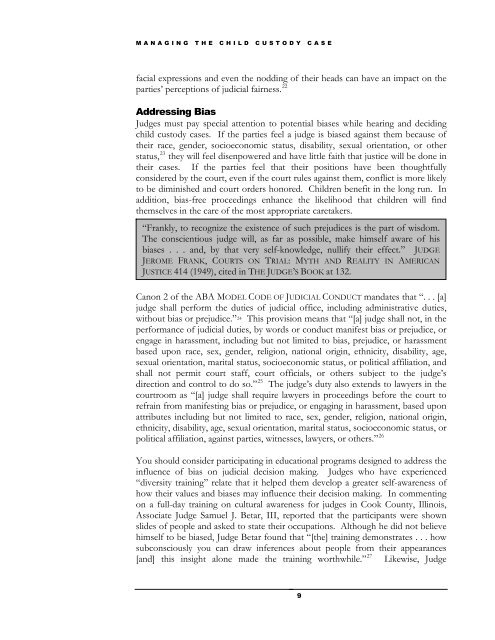A Judge’s Guide
A Judge’s Guide
A Judge’s Guide
Create successful ePaper yourself
Turn your PDF publications into a flip-book with our unique Google optimized e-Paper software.
MANAGING THE CHILD CUSTODY CASE<br />
facial expressions and even the nodding of their heads can have an impact on the<br />
parties’ perceptions of judicial fairness. 22<br />
Addressing Bias<br />
Judges must pay special attention to potential biases while hearing and deciding<br />
child custody cases. If the parties feel a judge is biased against them because of<br />
their race, gender, socioeconomic status, disability, sexual orientation, or other<br />
status, 23 they will feel disenpowered and have little faith that justice will be done in<br />
their cases. If the parties feel that their positions have been thoughtfully<br />
considered by the court, even if the court rules against them, conflict is more likely<br />
to be diminished and court orders honored. Children benefit in the long run. In<br />
addition, bias-free proceedings enhance the likelihood that children will find<br />
themselves in the care of the most appropriate caretakers.<br />
“Frankly, to recognize the existence of such prejudices is the part of wisdom.<br />
The conscientious judge will, as far as possible, make himself aware of his<br />
biases . . . and, by that very self-knowledge, nullify their effect.” JUDGE<br />
JEROME FRANK, COURTS ON TRIAL: MYTH AND REALITY IN AMERICAN<br />
JUSTICE 414 (1949), cited in THE JUDGE’S BOOK at 132.<br />
Canon 2 of the ABA MODEL CODE OF JUDICIAL CONDUCT mandates that “. . . [a]<br />
judge shall perform the duties of judicial office, including administrative duties,<br />
without bias or prejudice.” 24 This provision means that “[a] judge shall not, in the<br />
performance of judicial duties, by words or conduct manifest bias or prejudice, or<br />
engage in harassment, including but not limited to bias, prejudice, or harassment<br />
based upon race, sex, gender, religion, national origin, ethnicity, disability, age,<br />
sexual orientation, marital status, socioeconomic status, or political affiliation, and<br />
shall not permit court staff, court officials, or others subject to the judge’s<br />
direction and control to do so.” 25 The judge’s duty also extends to lawyers in the<br />
courtroom as “[a] judge shall require lawyers in proceedings before the court to<br />
refrain from manifesting bias or prejudice, or engaging in harassment, based upon<br />
attributes including but not limited to race, sex, gender, religion, national origin,<br />
ethnicity, disability, age, sexual orientation, marital status, socioeconomic status, or<br />
political affiliation, against parties, witnesses, lawyers, or others.” 26<br />
You should consider participating in educational programs designed to address the<br />
influence of bias on judicial decision making. Judges who have experienced<br />
“diversity training” relate that it helped them develop a greater self-awareness of<br />
how their values and biases may influence their decision making. In commenting<br />
on a full-day training on cultural awareness for judges in Cook County, Illinois,<br />
Associate Judge Samuel J. Betar, III, reported that the participants were shown<br />
slides of people and asked to state their occupations. Although he did not believe<br />
himself to be biased, Judge Betar found that “[the] training demonstrates . . . how<br />
subconsciously you can draw inferences about people from their appearances<br />
[and] this insight alone made the training worthwhile.” 27 Likewise, Judge<br />
9


